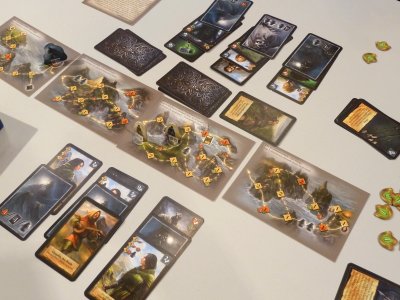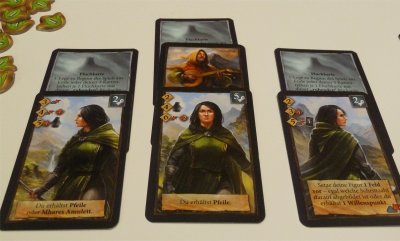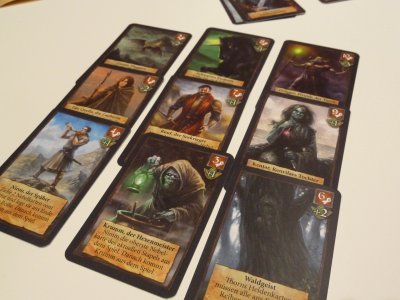

![[IMAGE]](../bilder/andorct1.jpg) |
Designer: Publisher: No. of Players: |
![[IMAGE]](../technik/box/rot/rot-5.gif) ![[IMAGE]](../technik/box/gelb/gelb-8.gif) ![[IMAGE]](../technik/box/grun/grun-8.gif) ![[IMAGE]](../technik/box/pink/pink-9.gif) ![[IMAGE]](../technik/box/blau/blau-7.gif) |
|
The popularity of fantasy adventure boardgames has seen a considerable comeback in 2012 with the release of Michael Menzel's award-winnig The Legends of Andor. Apart from the quite stunning artwork which was done by the game designer himself, the game offers a quite interesting cooperative strategic approach, challenging the players to think quite well which steps they should take with their adventurers. Even though dice are used to determine the outcome of a combat, there is no simple hack'n slash like in 1980's adventure boardgames, and so it is no wonder that the game has seen one major expansion, two smaller add-ons and nearly a dozen promo items. The big Legends of Andor: Journey to the North expansion has seen the group of adventurers travel northwards to help rescue the far-away Kingdom of Hadria, but now the new 2-player spin-off game Die Legenden von Andor: Chada & Thorn sees the two main heroes, Chada the archeress and Thorn the figher, on their voyage back to Andor to answer a call of the King. In addition, the first Andor-novel also will be released in a couple of days, written by Michael Menzel's wife Stefanie Schmitt who had also been responsible for all the atmospheric card texts in the boardgame. The book will deal with the prologue of the Legends of Andor boardgame, and as a nice sweetener it will also contain an extra card for the game.
![[SPIEL]](.. /specials/messe/essen15/ess15156.jpg) As indicated, Die Legenden von Andor: Chada & Thorn is a spin-off of the Andor-series, meaning that it develops the story further without actually expanding the main game. This can also be seen by the fact that this game has been designed by Gerhard Hecht, thus giving Michael Menzel a possibility to return to the role of illustrator and creative director. Once again, the game is purely cooperative, putting the two players up to the task to guide Chada and Thorn through 4 arduous stages of their homeward voyage. Although the general course of each of the four stages is similar, there is no need to play them all at once as each stage is a game of its own. In addition, just like the big Die Legenden von Andor game, Die Legenden von Andor: Chada & Thorn features some additional Adventure cards for each stage, thus allowing the game to be replayed without becoming too repetitive. Quite unexpectedly, the Adventure cards used for each stage of the journey do not list any kind of events which the heroes will have to solve. In this game the role of Event cards has been assigned to a deck of Fog card, listing an assortment especially of monsters and other enemies which the heroes might encounter. The Adventure cards on the other hand are used to depict the route of the heroes, with four cards coming together to form a small gameboard showing the possible routes the characters have to take and the events which may happen along the way.  Each player begins each stage in possession of three Hero cards showing his chosen character in three different poses. These cards will be placed next to each other in front of the player, thus marking the beginning of three individual card rows held by each player. Behind each Hero card, with a slight shift to remain partly visible, a randomly drawn Curse card will be placed, and apart from some Will-point markers these sets of six cards per player are all they get to start on a stage of the journey. Both Hero figures then will be placed on their starting positions on the first of the four Adventure cards, and the game begins with the first player turn. Using a mechanism similar to the one Gerhard Hecht had employed in Kashgar: Händler der Seidenstraße, during their turns the players always are obliged to use one of the three cards at the beginning of one of their card rows. During the first turn of each player this will be one of the three Hero cards, but after the card is used it will be moved to the end of its row, now moving all cards which have been behind one step forwards. During the start phase this means that one of the Curse cards now will be the top card of its row, and sooner or later the players will have to play one of their Curse cards in order to get back the Hero card behind it.  As can be suspected, the Hero and Curse cards are not the only cards forming the three card rows, but during the course of the game the players will add Enemy cards appearing on Fog cards, allies or useful equipment, and all these cards will be added to the back of the card row from which the top card has been used for the player's current action. This way the card rows will get longer, challenging the players to coordinate their cardplay in order to run the game efficiently. The Hero cards are the centerpiece for a player's actions, since they can be used for moving the Hero figure on the gameboard, for fighting against Enemy cards and for activating the special abilities listed on the card. A well timed use of the three abilities of each hero card is quite essential, since the game puts several challenges against the heroes which need to be overcome in due time. On the one hand, the Hero figures need to keep moving on their travelling route over the four Adventure cards, since a Curse figure - triggered by the Curse cards - will keep moving behind them, making the players loose the game if the Curse figure ever catches up with one of the heroes. Like in other adventure games, quite a few things may happen along the route, and so the players have to spend varying amounts of movement points for each step, and they will have to face events like the drawing of Fog card, the loss of Will-point markers etc. as depicted on the Adventure cards. As indicated, the Fog cards usually trigger the appearance of enemies, and at the same time they also serve as a timer since only a limited amount of Fog cards is assigned to each Adventure card. If this deck runs out and the players have to draw another Fog card, the game will be lost as well. Enemies depicted on Fog cards will be added to the end of the card row from which the player has used the top card for his current action. Later on, such Enemy cards will be available for combat at the beginning of their card row, and they must be defeated to keep the card row from being blocked, ending the game if all three of a player's rows are locked up this way. Now the player can use a Hero card lying on top of one of his other rows to defeat the enemy, provided the Hero card is strong enough to do so.  At this point the game gets highly interactive, since the relative positioning of the two Hero figures on the "gameboard" allows the players to defeat an enemy in one of the other player's card rows if the two Hero figures are on adjacent spaces. Likewise, the heroes can join forces or exchange Will-points and Equipment cards if they are on adjacent spaces, and so the players have to strive to stay as close together as possible. While this may actually sound easy, the composition of the routes and the abilities of the Hero cards often may force the one or other hero to take a detour, and so it becomes an interesting challenge to adjust cardplay and timing to get the heroes back together. As can be imagined, the level of complexity grows with each new card added to one of the players' rows, and the players will have to keep their card rows in balance by adding valuable Equipment cards and other cards with positive effects. This is essential since each new card added to a card row actually will delay the reappearance of one of the three Hero cards, and so the Equipment cards with their limited field of use can partly replace the Hero cards when it comes to defeating monsters or moving. A stage of the game is won if both Hero figures are able to reach the final space on the fourth Adventure card before the game tips against them due to one of the ending conditions. As indicated, each of the four stages can be played separately, and indeed the players will not take anything forwards from one stage to the next. Die Legenden von Andor: Chada & Thorn is not only a nice continuation of the story begun in Die Legenden von Andor, but it actually puts the players to solve a puzzle of similar complexity. Just like the bigger game, timing issues are really important here, but instead of spending time for actions the players now will have to focus on coordinating their cardplay, keeping an eye on the cards which will sooner or later re-appear in each of their card rows. Due to some special cards and conditions each of the four stages of the game has some minor unique elements, and the replay value is increased due to the alternative Adventure cards which can be used on a random basis. Fans of the world of Andor will greatly appreciate this atmospheric new chapter in the stories of the main heroes, and also other players with a liking for cooperative adventure games should not shy back from giving the game a try. For players being new to the world of Andor the setting may be a bit unusual since it only covers part of a major story, but the game offers an interesting challenge and enough atmosphere to be played for its own merits. | ||
|
| ||

|
|

|
|
| ||
|
Impressum / Contact Info / Disclaimer Kulkmann@aol.com
Copyright & copy; 2015 Frank Schulte-Kulkmann, Essen, Germany | ||